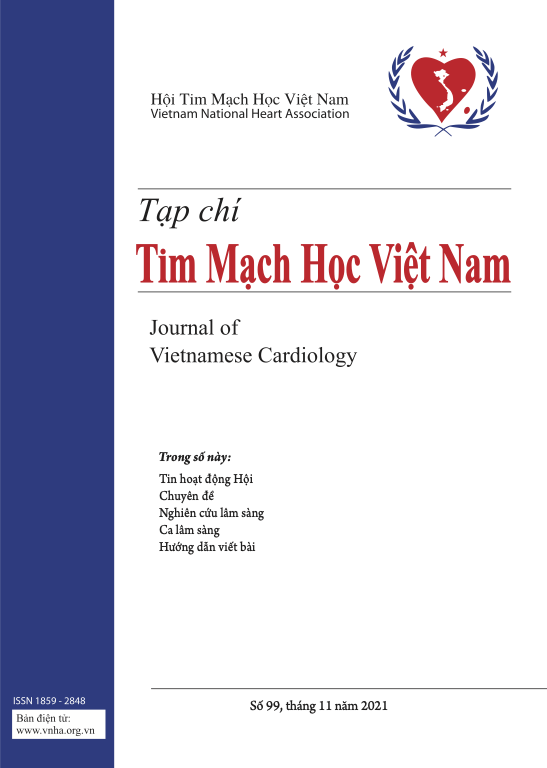Nghiên cứu về thời gian hồi phục tần số tim ở người khỏe mạnh và bệnh nhân suy tim tại Việt Nam
DOI:
https://doi.org/10.58354/jvc.97.2021.120Tóm tắt
Thời gian hồi phục nhịp tim được xem là một công cụ hiệu quả để đánh giá các rối loạn thần kinh thực vật, một yếu tố tăng nguy cơ mắc bệnh lý Tim mạch và tiên lượng tử vong ở người bệnh suy tim. Nghiên cứu của chúng tôi nhằm đánh giá hồi phục nhịp ở đối tượng người Việt Nam khỏe mạnh và ảnh hưởng của suy tim lên hồi phục nhịp tim và hệ thống thần kinh tự chủ.
Nghiên cứu được tiến hành theo phương pháp mô tả cắt ngang bao gồm 129 đối tượng, trong đó có 84 đối tượng khỏe mạnh và 45 người bệnh suy tim phân độ B, C theo AHA. Hồi phục nhịp tim được định nghĩa là hiệu số tuyệt đối giữa nhịp tim tối đa đạt được trong quá trình gắng sức với nhịp tim được đo sau 1 và 2 phút sau nghiệm pháp gắng sức với xe đạp lực kế.
Hồi phục nhịp tim ở người khỏe mạnh được chia thành hai pha nhanh và chậm, đồng thời chưa trở về bình thường sau 4 phút theo dõi. Hồi phục nhịp tim ở người bệnh suy tim chậm hơn so với đối tượng người khỏe mạnh sau 1 phút (20,8 ± 7,6 so với 30,2± 11,3 nhịp/phút) và sau 2 phút (33,9 ± 8,7 so với 42,7 ± 10,6 nhịp/phút). Giá trị ngưỡng phân định giữa đối tượng khỏe mạnh với người bệnh suy tim ở Việt Nam là 24,5 nhịp/phút với hồi phục nhịp tim sau 1 phút và 40,5 với hồi phục nhịp tim sau 2 phút.
Từ khóa: Hồi phục nhịp tim, suy tim.
Tài liệu tham khảo
1. ChâuNQ,ViệtNL,AnhNĐ,VinhPQ. BệnhhọcNộikhoa. Suy tim. Nhà xuất bản Y học; 2012.
![]()
2. RovereMTL,SpecchiaG,MortaraA,SchwartzPJ. Baroreflex sensitivity, clinical correlates, and cardiovascular mortality among patients with a first myocardial infarction. A prospective study. Circulation. 1988;(78):816 - 824.
![]()
3. WichterleD,SimekJ,RovereMTL,SchwartzPJ,CammAJ,MalikM. Prevalent low-frequency oscillation of heart rate: novel predictor of mortality after myocardial infarction. Circulation2004;(110):1183–1190.
![]()
4. EckbergDL,DrabinskyM,BraunwarldE. Defective cardiac parasympathetic control in patients with heart disease. N Engl J Med. 1971;(285):877–883.
![]()
5. Pagani M, Malfatto G, Pierini S, et al. Spectral analysis of heart rate variability in the assessment of autonomic diabetic neuropathy. JAutonNervSyst. 1988;(23):143 - 153.
![]()
6. Malliani A, Pagani M, Lombardi F, R Furlan, Guzzetti S, Cerutti S. Spectral analysis to assess increased sympathetic tone in arterial hypertension. Hypertension. 1991;(17):36 - 42.
![]()
7. KinugawaT,Dibner-DunlapME. Altered vagal and sympathetic control of heart rate in left ventricular dysfunction and heart failure. AmJPhysiol. 1995;(268):310 - 316.
![]()
8. Laterza MC, Matos Ld, Trombetta I, et al. Exercise training restores baroreflex sensitivity in never- treated hypertensive patients. Hypertension. 2007;(49):1298 - 1306.
![]()
9. BuchheitM,PapelierY,LaursenPB,AhmaidiS. Noninvasive assessment of cardiac parasympathetic function: postexercise heart rate recovery or heart rate variability? PhysiolHeartCircPhysiol. 2007;(293):8 - 10.
![]()
10. LauerMS. Heart rate recovery: what now? JInternMed2011;(270):597 - 599.
![]()
11. Morshedi-MeibodiA,LarsonMG,LevyD,O’Donnell CJ, Vasan RS. Heart rate recovery after treadmill exercise testing and risk of cardiovascular disease events (The Framingham Heart Study). Am J Cardiol 2002;(90):848 - 852.
![]()
12. RacineN,BlanchetM,DucharmeA,etal. Decreased heart rate recovery after exercise in patients with congestive heart failure: effect of beta-blocker therapy. JCardFail2003;(9):296 - 302.
![]()
13. PeçanhaT,Silva-JúniorND,ForjazCLdM. Heart rate recovery: autonomic determinants, methods of assessment and association with mortality and cardiovascular diseases. Clin Physiol Funct Imaging. 2013;(34):327 - 329.
![]()
14. UshijimaA,FukumaN,KatoY,AisuN,MizunoK. Sympathetic excitation during exercise as a cause of attenuated heart rate recovery in patients with myocardial infarction. JNipponMedSch. 2009;(76):76 - 83.
![]()
15. JouvenX,EmpanaJ-P,SchwartzPJ,DesnosM,CourbonD,DucimetièreP. Heart-rate profile during exercise as a predictor of sudden death. NEnglJMed. 2005;(352):1951–1958.
![]()
16. ColeCR,FoodyJM,BlackstoneEH,LauerMS. Heart rate recovery after submaximal exercise testing as a predictor of mortality in a cardiovascularly healthy cohort. AnnInternMed2000;(132):552 - 555.
![]()
Tải xuống
Đã Xuất bản
Các phiên bản
- 04-03-2023 (2)
- 04-03-2023 (1)








